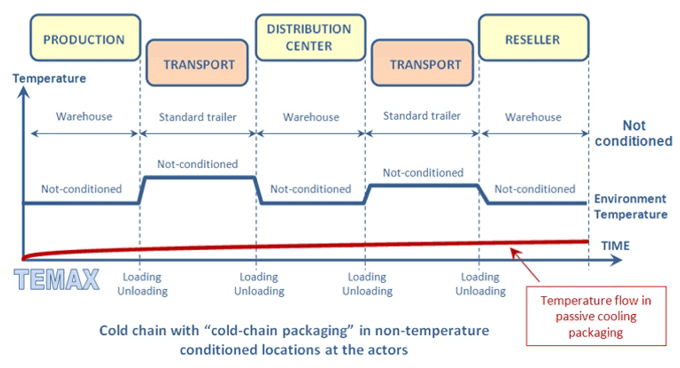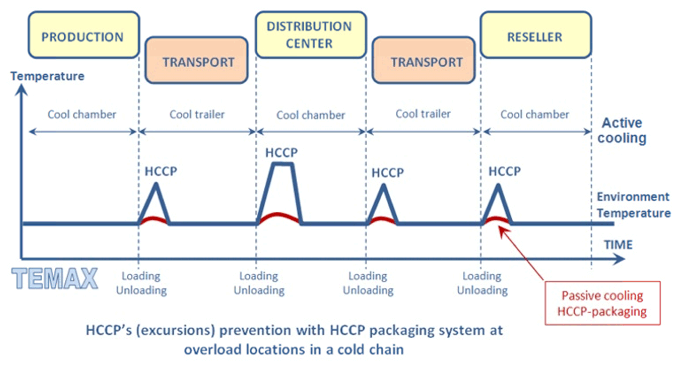You are here: English > Cold Chain > Cold chain passive cooling
Another way to guaranty the required temperatures in a cold chain is using passive cooling or passive packaging which means that no electrical or mechanical engines are being used to create a certain temperature controlled environment. In passive cooling insulation materials are used as a packaging system to protect the own temperature of the product against unwanted external or outer temperatures. A passive cooling can be used to insulate the product individually or as a group as on pallets or roller containers for example. When using a passive cooling system it is the quality of the insulation material which determines the temperature preservation or temperature result. The better the insulation quality,the better the temperature results. It is therefore a matter of determining the most ideal insulation quality in an optimal passive cooling system. The advantage of a passive cooling is that the product is protected at all times which gives the opportunity to close the cold chain totally which is very difficult in a cold chain with active cooling. This also explains why more and more companies are exploring the possibilities of passive cooling to distribute temperature sensitive products as pharmaceuticals medicines food and chemicals.
Total cold chain passive packaging – cooling
A first kind of passive packaging or passive cooling that can be used to protect time-temperature sensitive products is a passive packaging system which offers a temperature protection over the total cold chain. This is a special designed passive packaging where extra thermal energy is added (gel packs, ice packs, phase change elements, etc...) in order to maintain the required temperature over a long duration of time. The advantage of this packaging system is the guaranty for a good temperature preservation. A disadvantage is the impact on the payload (more volume + more weight) which creates extra costs on the transport. Below is shown a cold chain with a total cold chain passive packaging system.

HCCP Packaging for temperature protection on the HCCP's in a cold chain with active cooling
Passive cooling can also be used in combination with active cooling as a solution to the HCCP’s in the cold chain. If goods are being send on a pallet size for example, insulated covers can be used to protect the goods during the overloading procedures between two temperature controlled environments where the HCCP’s are active. The insulated covers, which function as a HCCP-packaging system, make sure that the temperature fluctuations are not as extreme or are limited to a minimum so the HCCP’s do not have such a big impact on the temperature fluctuations and the temperatures stay steady, increasing the quality of the goods. If we take a closer look at the temperature results on an integrated passive cooling or packaging in a cold chain with active cooling we see the following situation.

The graphic above shows the temperatures (red line) in a cold chain in which all the actors in the chain use an active cooling. At the HCCP’s in the chain a significant temperature fluctuation can be seen depending on time and temperature heights. These temperature fluctuations can influence the quality of the goods. To reduce the time and heights of the fluctuations in the HCCP’s a passive cooling or packaging can be used to decrease the impact of the HCCP’s and keep the temperature of the goods steady (green line).
Experience show that in the pharmaceutical industry active cooling is being used mostly for the (+2°C to +8°C) product groups when bigger loads as pallet size loads are being transported. In this product range the HCCP’s are active and an additional passive cooling / packaging would bring a significant improvement to the product quality. Seeing an active cooling is used through the total cold chain, the insulation quality of the passive packaging does not need to be that high. Of course, this is depending on the impact of the HCCP’s in the cold chain. Therefore it is advisable to implement controlling and monitoring systems in the cold chain to measure the impact and the height of the HCCP’s.
Types of passive cooling or passive packaging in a cold chain
When talking about passive cooling or passive packaging, we said that the conditioned goods are being packed in an insulated packaging with the goal to maintain the temperature of the goods during the transport time in the total cold chain. To do this two types of passive packaging can be used according to the logistic process being
- Single use or one-way use packaging
- Multiple use or re-usable packaging
A single use ore one-way use insulated packaging is a packaging which is used only one time. The goods are being packed in the insulation material and the receiver of the goods will destroy the packaging. This kind of passive cooling or passive packaging is mostly used in insulated cardboard boxes and long or far transports as air freight or sea transport. The disadvantage of a single use or one-way use passive cooling is that it will create waste at the receiver. When using single use or one-way passive cooling or passive packaging the following themes are therefore very important
- The volume of waste that is being created at the receiver
- The waste handling at the receiver (recyclable materials, etc…)
- Possible costs for the receiver for the waste handling
A multiple use or re-usable passive cooling or insulated packaging is a packaging which can be used several times. The goods are being packed in the insulation material and the receiver of the goods sends the insulation material / packaging back to the sender so it can be re-used. This kind of packaging is mostly used in road transport when the receiver is located not too far from the sender and if the sender has a frequent transport to the same receiver so the insulation material of packaging can be picked-up. When using multiple use re-usable passive cooling or packaging the following themes are very important.
- Duration of life of the insulated material / packaging (how many uses?)
- Possible return-flow from receiver to sender
- Cleaning ability of the insulated material / packaging (hygiene) = contamination danger
- Traceability of the insulated material / packaging (location in the distribution chain)
- QA Quality Assurance = Thermal quality control before each re-use (How - Who - Where ?)
So when the need for passive packaging or passive cooling is required one of the first questions will be what the most ideal type of packaging will be, one way use or re-usable.




